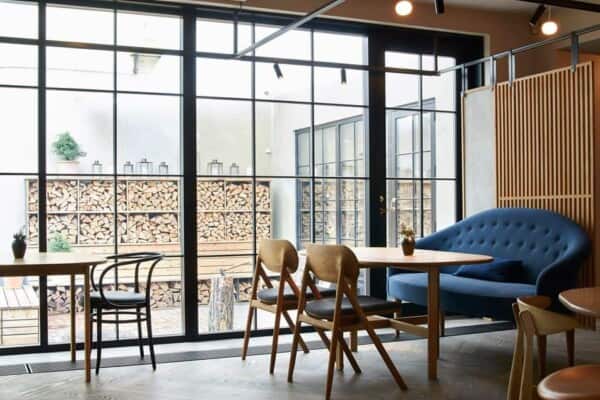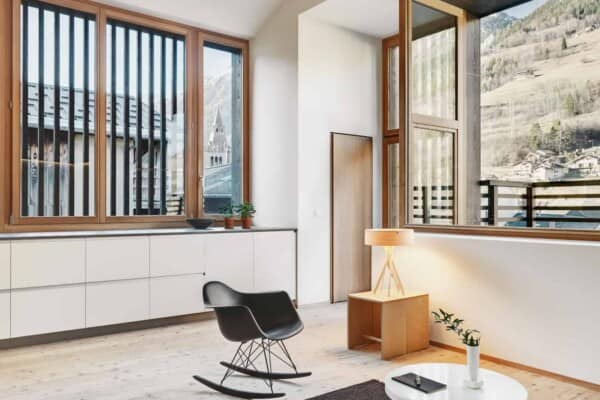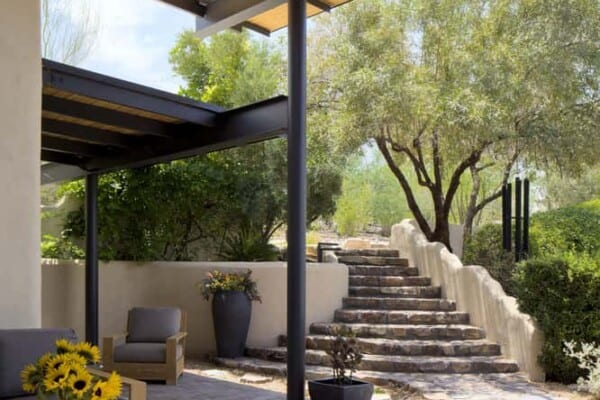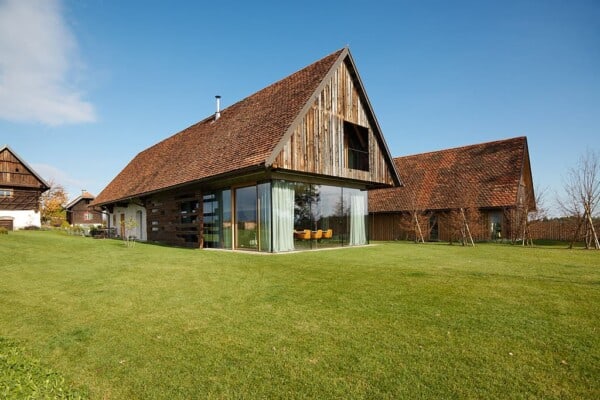The Hotel Aire de Bardenas is located in Tudela, Navarre, Spain.
It was designed in 2007 by Emiliano Lopez Monica Rivera Arquitectos.
Hotel Aire de Bardenas by Emiliano Lopez Monica Rivera Arquitectos:
“The place
In the southernmost part of Navarre, near the desert-like landscape of the Bardenas and surrounded by the green of the market gardens and orchards along the banks of the Ebro River lies Tudela, the second city in the region in terms of both size and importance and one of the main eolic energy producers in Europe.
The site for the four-star hotel is a wheat field, located 3 km (1.86 mi) from Tudela’s town center and 4 km (2.48 mi) away from the Bardenas Reales de Navarra, a spectacular natural park with semi-desert landscape.
Commission
The clients, who had no prior experience in the hospitality business, commissioned a one storey, 22 room hotel on the wheat field which is surrounded by an imposing landscape; the arid Bardenas on one side and the green cultivated fields, the Ebro River and Tudela on the other. A strong characteristic of the site is its exposure to very strong winds –hence the name of the hotel, meaning Air in Spanish– and the extreme temperatures. Conditions established by the clients from the beginning of the project were for the new building to be built using entirely dry-construction and to work as much as possible with steel elements, as they counted with the collaboration of an excellent local metal worker.
Another determining condition was the limited budget and construction time; it had to be completed with 1.8 million euros and finished in 12 months from the city construction permit approval’s date. After initial meetings with the client, in order to meet the budgetary constraints, we decided to employ a system of metal sandwich façade panels with a rigid foam core, because of its fast assembly time, the metal fabricator’s prior experience in handling this material, its excellent thermal insulation qualities. The steel elements and façade panels were prefabricated at the metal shop while the site work, installations and concrete slabs were being completed, and later assembled on site extremely fast. The building was completed in 12 months.
Design Concept
Given the site’s great views and strong winds, we conceived the hotel as a succession of protected and comfortable interior spaces from which to contemplate the exterior.
The architecture, interior spaces and landscape design, seek to bring the dweller close to the rural and austere character of the surroundings by providing simple, generous and silent spaces.
Recycled, large wooden containers typically found in Tudela’s crop fields for fruit and vegetable recollection and transportation were employed as windbreakers for the hotel’s outdoor spaces. They stop strong wind while allowing air to pass, need no foundations or fixings and are easy to move.
From the exterior, the hotel intentionally blurs with the surroundings. It presents itself as a lightweight construction that can be dismantled and recycled, recalling the local agricultural constructions, such as barns and vegetable coops found in the area.
The building
In its arrangement, the hotel keeps the forms of the noble constructions found in the riverbank area, the Ribera, which developed around a central court, offering climactic protection. The entral court, generated by a series of orthogonal constructions, gives its back to the Cierzo (the 2 / 2 strong north-west wind) and opens up to the southeast, where a plantation of poplar trees and the pool are located.
The building is composed by a series of simple monochromatic cubic tructures. Their dispersed arrangement allows views through the interstitial spaces, minimizing a massive appearance and generating an animated play of light and shadow. Through an ordered plantation of white-flower cherry trees, one enters the hotel’s main body which houses the common areas – reception area, main hall, meeting room, bar and restaurant– and 10 rooms with private patios, each with a fruit tree. The rest of the rooms are freestanding pavilions with large projecting windows overlooking the open landscape. Access to these rooms is through an exterior walkway, providing them with a private and privileged character by their being right out in the wheat fields. The treatment of the exterior spaces, translate the characteristic forms, colors and vegetations of the Bardenas desert and the surrounding irrigation fields: ordered plantations of fruit trees, vegetable gardens, scattered placement of aromatic plants such as rosemary and thyme.
Ground surfaces were covered with local reddish earth and boulders extracted from the site, which mark the limit between the wheat plantation and the hotel. Smaller boulders and pebbles were also used as aggregate for the exterior and interior polished concrete floors, resulting in particular terrazzo finish.
Rooms
Upon entering the rooms, separating the entry from the sleeping area, one finds a vestibule-like space with a freestanding and open furniture piece that offers a comfortable and generous place to leave belongings and avoid having them visually cluster the sleeping area. It also contains the mini-bar, safe and shelves with outlets for recharging electronic items. The toilet has its own separate space with door while the shower or bathtub is adjacent to a window or a door (in the case of the rooms with private patio) and to the bed area separated by airy white cotton curtains. The bathtubs, shower plates, ashbasins -fabricated in folded and powder-coated steel sheet- and most of the furniture (beds, tables, luggage furniture, armchairs in main hall, low stools…) were designed by the architects specifically for this project and made by the metal fabricator who did the building.
Inhabitable window
To reinforce the idea of the rooms as protected outdoorviewing devices, we created projecting windows with no visible glass frame from the interior. The windowsill becomes inhabitable by the exaggeration of its depth and by lining its interior with plywood. This lining conceals the glass’ metal frame and the solar filtering devices that roll down electrically. The window is perceived as a simple unglazed opening that creates a false perception of thickness not inherent to the light construction employed.
These inhabitable windows become snug places to read or watch the TV, or simply to contemplate the views. It serves also as seating or as an extra bed for the rooms. Their orientation is mainly northeast to allow seeing the illuminated landscape, without receiving direct sunlight.”
Photos by: José Hevia














































